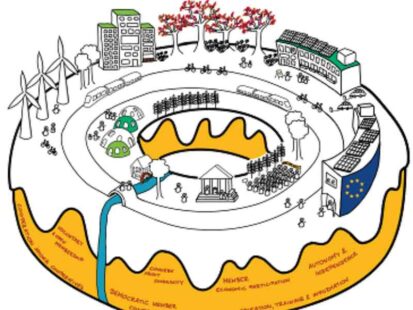
Both in concept and practice, energy communities have had a rapid surge in interest. Yusuf Latief investigates their value case and looks at how financing challenges rewired might just add spark to their speed.
The concept of energy communities — formed by local community members to invest in renewable energy – has been developing rapidly with new approaches on the rise.
Demonstrating their importance, REScoopEU, the European Federation of renewable energy citizen energy cooperatives, uses and builds on the concept of the ‘doughnut economy’, a visual framework developed by economist Kate Raworth to combine the concepts of planetary and social boundaries.
According to the federation, which consists of different citizen energy communities as members, the doughnut visual represents a locally-based energy transition, encouraging a perspective where energy-savvy citizens interact with their local governments and there is fluid communication between citizens and the European Union.
Energy communities & citizen engagement
Heleen Schockaert, REScoopEU Project Manager, explains that REScoopEU “created this vision of the doughnut to give some visual cues when we communicate about how we see ourselves acting within the energy system, what we think could be the meaning of citizen engagement in the energy system and to get everyone on board of this energy transition”.
She adds: “Central to the doughnut is our vision of energy as a common, and not as a commodity. This perspective opens up towards environmental impacts and social and moral implications, and those towards more systemic solutions to address the grand challenges that we face today.”
One such grand challenge, and a key way energy communities have been proving their value, relates to the increasingly recognised issue of grid stress.
Energy communities, by acting as decentralised units of energy management, might hold the answer to this in how they are managed, locally generating, distributing and even sharing renewable energy.
For example, in 2023 in Brussels, the heart of European politics, one such energy community project announced a move forward to study and demonstrate the impact of energy sharing, enabled by the community’s creation, on grid operations.
Have you read:
Energy communities and the example of the Greek Islands
How young people can contribute to energy communities
Belgian retail investor Nextensa has been working on the project alongside economic think tank Bruegel, electricity and gas distribution system operator Sibelga, and energy solutions developer WeSmart to set up the energy community around Tour&Taxis, a former industrial site in Belgium, and at the Maritime Station, which includes the station, its parking lot, the Park Lane and the Post Office.
The project’s goals are two-fold: to identify the impact of large-scale electricity sharing on grid management; and to explore the potential incentives and obstacles for the development of similar initiatives.
The project has seen residents consuming locally-generated solar energy since May 2023. On the roofs of Gare Maritime, there are 10,000 solar panels generating 3,000MWh of renewable energy annually.
Most of this energy has until now been consumed by offices, commercial spaces, events and the Food Market located in the Gare Maritime – the surplus energy flowed directly back toward the power grid.
This next stage of the project, which will run until April 2024, will evaluate energy sharing models: a portion of the surplus energy is shared with residents, rather than being directed to the grid, at an attractive rate.
Empowerment at the grassroots
Beyond its grid implications, energy communities have been gaining a lot of ground for their ability to affect the livelihood of community members.
Going over the work done by REScoopEU, Schockaert also references Repowering London, an Horizon 2020 project that helps set up energy communities in deprived areas of Britain’s capital city.
“They set up energy communities… but they also take a step away, helping them set up by appointing local heroes, who are part of the social fabric of the community. Whenever they need advice, they can then turn to Repowering London,” says Schockaert.
Schockaert illustrated by explaining how, for example, energy communities are set up on social housing and consumers are given “a limited amount of electricity for free.
“Part of the revenues of the project go to energy efficiency funds, to organise people to help with energy usage, but also to save on their energy bills. And that also goes into training opportunities for young people.
“These young people are really core to the work that Repowering does and are a super inspiring example of how an energy community can really be built from the ground up.”
Have you read:
Green growing pains: What happens when renewables ‘grow up’?
The path to implementing Europe’s energy strategy
Financing challenges
Whether through the lens of grid management or on the grassroots level, empowering citizens and bettering livelihoods, the value case for energy communities is quite clear.
However, their deployment tends to come up against a hard-to-manoeuvre barrier — financing.
REScoopEU Development Manager Stanislas D’Herbemont says: “The big problem is the adequacy of financial tools and products that exist to support (energy communities’) development: the financial markets are not really set up to support the type of projects that community energy is developing right now.”
This problem is broken down into three key factors, explains D’Herbemont.
Firstly, the projects tend to be too small. “The types of projects we’re talking about are at a volume of around €30,000 to €35,000. These projects are looking at loans equivalent to 50% to 60% of the based investment.
“When talking to a bank about a loan investment of €15,000 to €20,000, it’s simply too small. You are going into a category of loan that is not interesting for a bank.”
Secondly, getting off the ground is hard.
D’Herbemont states how, because energy communities/projects are usually created by collective community investment, “the beginning is usually very hard in terms of pre-development and development costs simply because you have a very small group that doesn’t necessarily have the means that private investors have.
“The problem is the beginning — organisational support needs to happen from the get-go.”
Lastly, according to D’Herbemont, authorities and banking partners state ‘risk and collective governance’ as core issues when it comes to financing.
The first relates to how, when an energy communities organisation approaches for financing, it is usually with only one project, which is “extremely risky to invest in”. And because they are democratically constructed under the ‘one member, one vote’ concept, “it makes it difficult (…) as banking institutions to understand who bears the responsibility.
“And so, instead of trying to understand this specific model, they’d rather not,” states D’Herbemont
Although these mounting challenges persist, it is in recognising and accepting them that they will be overcome — “The most important thing to understand is that, indeed, profit will not be the main focus,” adds D’Herbemont.
Rather, he counters, investors should see their benefit through the lens of impact.
“It’s looking at how to create the maximum amount of benefits at the local level: on ESGs, democratisation, social inclusion, climate and transition, sobriety and efficiency; looking at those things we need for the energy transition while at the same time preserving a long-term sustainable investment that will remain the base of your portfolio.”
Not as a short-term return, but rather as a means for investors to place their money where the energy transition is heading. “That is something that energy communities are really good at delivering.
“The problem is to find that right balance between understanding that [investor’s] money needs to be safe and at the same time respecting that democratic governance is key to preserving the long-term development of those organisations.”




